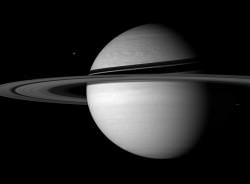If you were on the surface of Saturn, how long would a day last? This has remained a mystery for scientists, because the thick clouds of gas obscure the surface of the planet from direct observation by telescopes or orbiters. Below all those clouds there is a surface that rotates at a constant speed. Since scientists can’t directly see the surface, they’ve taken another approach: listening.
You can also check out these cool telescopes that will help you see the beauty of planet Saturn.
With the help of radio emissions that come from the interior of Saturn, scientists have been able to close in on its rotation period. Charged particles trapped in the interior emit radio waves when they interact with Saturn’s magnetic field, at about 100 Kilohertz. It’s as if Saturn had its own radio station broadcasting at a certain frequency, and as the magnetic field deep inside the planet rotates it changes the frequency of the station.
Voyager measured these emissions for nine months when it passed by in the 1980s, and the rotation was calculated to be 10 hours 39 minutes 24 seconds, with an uncertainty of 7 seconds. The Ulysses spacecraft also monitored the emissions 15 years later, and came up with a result of 10 hours 45 minutes 45 seconds, with a 36 second margin of error.
Wait, that’s 6 minutes of difference! Either Saturn slowed down a lot over the years, or something else is going on. Cassini has been measuring these same radio emissions with its Radio and Plasma Wave Science instrument, and has observed that in addition to this long-period variation, the rotation differs by as much as one percent in a week.
Scientists think that this could be due to two different things: the solar wind coming from the Sun is interfering with the measurements, or particles from Enceladus’ geysers are affecting the magnetic field. Both of these would cause the radio emissions to vary, and they could be causing the different results simultaneously.
Cassini’s new data strongly suggests that the solar wind is a likely culprit: there is a variation in the measurements of the short-period rotation every 25 days, which corresponds with the rotation of the Sun as seen from Saturn. The speed of the solar wind, too, varies the measurements, so must be accounted for. Enceladus could be the cause of the long-term difference, but more measurements are needed to see if this is definitely the case, or if there is yet another factor.
Nailing down the rotation of Saturn will be helpful in calculating the true wind speeds of the clouds, and give important clues about the composition and distribution of the interior. Once the interference from the solar wind and Enceladus are taken into account, the true rotation of Saturn can be determined precisely.
Then only one question remains: do they have commercials on Saturn FM?
Source: ESA News Release


Hi,
I wasn’t aware of this particular issue.
Isn’t it possible to “look” through Saturn’s clouds with some sort sensor that acts outside the visible spectrum (and see some features below)?
FM is around 100 _M_Hz
100 kHz is even below the long wave broadcasting range.
http://en.wikipedia.org/wiki/Longwave
No bandwith available for commercials there
“Surface” is a term hardly fit for a gas giant, IMHO. The clouds gradually thicken to the liquid hydrogen stratus at the interior…but then, I doubt one can see anything, supposing there are sentient lifeforms in a gas giant’s athmosphere. Maybe they don’t even haven’t “eyes”
Anyway, Merry Christmas!
Deep down Saturn gets really hot, so there’s no clouds due to. Once the gas hits about 0.83 density of water it’s a molecular fliud – a big ocean of the stuff until it’s turned into metallic hydrogen even further down.
By day, do you mean the period when the Sun is ‘up’, or the rotational period? If you mean the first suggestion, I’ve no clue. If you mean the second suggestion, 10.5 Earth hours. Why are we even disscussing this? Why are scientists disscussing it? Just pick up a book for goodness sake! It’s child’s play! I’m eleven and I knew that! Come on people, work those brains!
-geniusgirl_123
KissKiss!